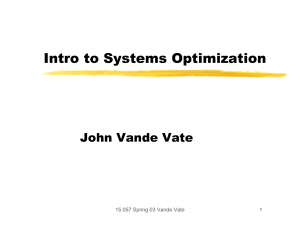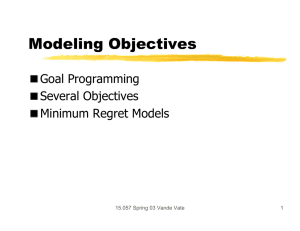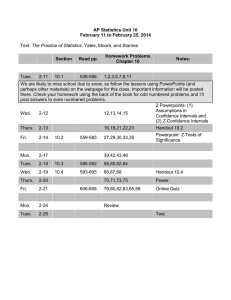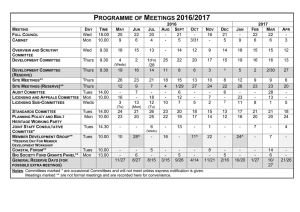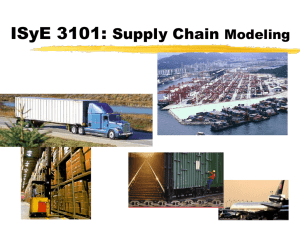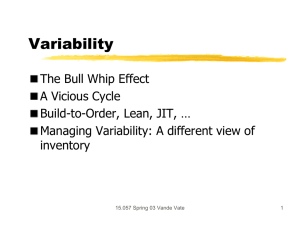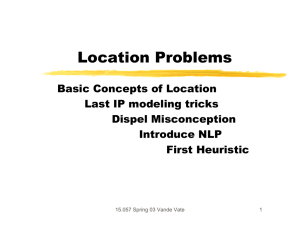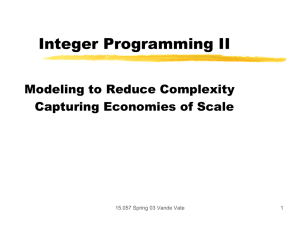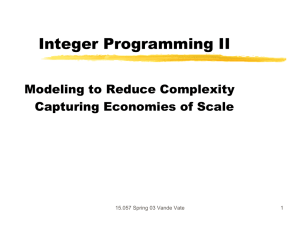Document 13619643
advertisement
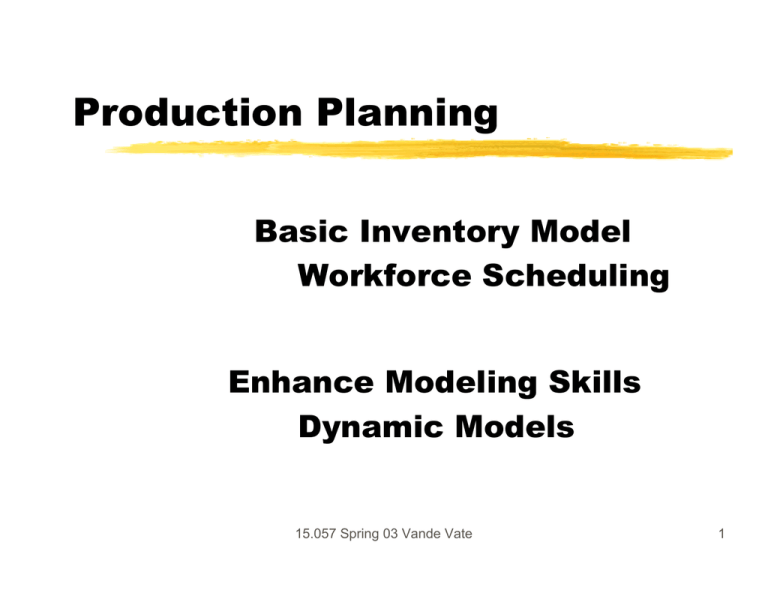
Production Planning
Basic Inventory Model
Workforce Scheduling
Enhance Modeling Skills
Dynamic Models
15.057 Spring 03 Vande Vate
1
Dynamic Inventory Model
Modeling Time
Modeling Inventory
Unusual Network Example
15.057 Spring 03 Vande Vate
2
Singapore Electric Generator
Unit Costs
Production $
Inventory $
Production Qty
Production Limits
Beginning Inventory
Delivery Reqmts
Ending Inventory
Production Cost $
Inventory Cost $
Total Cost $
Singapore Electric Generator Production
Jan
Feb
Mar
Apr.
28.00 $
27.00 $
27.80 $ 29.00
0.30 $
0.30 $
0.30 $ 0.30
0
60
15
58
(43)
0
62
-43
36
(79)
$
(4.20) $
(4.20) $
$
(18.30) $
(18.30) $
15.057 Spring 03 Vande Vate
0
64
-79
34
(113)
May
0
66
-113
59 Minimum
(172)
7
$
(28.80) $ (42.75) Total
(28.80) $ (42.75) $
(94.05)
3
Inventory
Balancing Your Checkbook
Previous Balance + Income - Expenses = New Balance
Modeling Dynamic Inventory
Starting Inv. + Production - Shipments = Ending Inv.
15.057 Spring 03 Vande Vate
4
Average Balances
Assuming Smooth Cash Flows
a Averages (Starting + Ending)/2
15.057 Spring 03 Vande Vate
5
Challenge
Formulate a Solver Model
15.057 Spring 03 Vande Vate
6
Singapore Electric Generator
Unit Costs
Production $
Inventory $
Production Qty
Production Limits
Beginning Inventory
Delivery Reqmts
Ending Inventory
Production Cost $
Inventory Cost $
Total Cost $
Singapore Electric Generator Production
Jan
Feb
Mar
Apr.
28.00 $
27.00 $
27.80 $ 29.00
0.30 $
0.30 $
0.30 $ 0.30
0
60
15
58
(43)
0
62
-43
36
(79)
$
(4.20) $
(4.20) $
$
(18.30) $
(18.30) $
15.057 Spring 03 Vande Vate
0
64
-79
34
(113)
May
0
66
-113
59 Minimum
(172)
7
$
(28.80) $ (42.75) Total
(28.80) $ (42.75) $
(94.05)
7
A Network Formulation
Jan.
mfg.
Feb.
mfg.
Mar.
mfg.
Apr.
mfg.
Supply ≤
Prod. Limits
Apr.
Inv.
May
Inv.
Production Variables
Dec.
Inv.
Inventory
Variables
Jan.
Inv.
Feb.
Inv.
Mar.
Inv.
Shipment Quantities
Jan.
dem.
Feb.
dem.
Mar.
dem.
15.057 Spring 03 Vande Vate
Apr.
Demand ≥ req
dem.
8
A Network Formulation
Singapore Electric Generator Production
Unit Costs
Dec
Jan
Feb
Mar
Apr.
Production
$
28.00 $
27.00 $
27.80 $ 29.00
Inventory
$
0.30 $
0.30 $
0.30 $ 0.30
Production Qty
Production Limits
Delivery Reqmts
Calc. Ending Inv.
Ending Inventory
Production Cost
Inventory Cost
Total Cost
0
60
58
-43
-
15
$
$
$
$
2.25 $
2.25 $
0
62
36
(36)
-
0
64
34
(34)
$
$
$
15.057 Spring 03 Vande Vate
-
May
0
66
59
(59) Minimum
7
$
$
$
-
Total
$
2.25
9
Another View
s.t. InitialBalance:
Production['Jan'] - EndingInv['Jan'] = 43
s.t. MonthlyBalances['Feb']:
Production['Feb'] + EndingInv['Jan'] - EndingInv['Feb'] = 36
s.t. MonthlyBalances['Mar']:
Production['Mar'] + EndingInv['Feb'] - EndingInv['Mar'] = 34
s.t. MonthlyBalances['Apr']:
Production['Apr'] + EndingInv['Mar'] - EndingInv['Apr'] = 59
s.t. FinalBalance:
EndingInv['Apr'] >= 7
15.057 Spring 03 Vande Vate
10
Scheduling Postal Workers
Each postal worker works for 5 consecutive
days, followed by 2 days off, repeated
weekly.
Day
Demand
Mon Tues Wed Thurs Fri
17
13
15
19
14
Sat
Sun
16
11
Minimize the number of postal workers
(FTE’s)
15.057 Spring 03 Vande Vate
11
Challenge
Formulate a Solver Model
15.057 Spring 03 Vande Vate
12
Formulating the LP
Scheduling Postal Workers
Shift
Day
Mon
Tues
Wed
Thurs
Fri
Sat
Sun
Mon - Tues - Wed - Thurs - Fri - Sat - Sun Fri
Sat
Sun Mon Tues Wed Thurs
1
1
1
1
1
1
1
1
1
1
1
1
1
1
1
1
1
1
1
1
1
1
1
1
1
1
1
1
1
1
1
1
1
1
15.057 Spring 03 Vande Vate
1
Demand
17
13
15
19
14
16
11
13
Formulating as an LP
The Objective
Total Workers Required
Minimize $I$5
The decision variables
The number of workers assigned to each shift
$B$5:$H$5
The Constraints
Enough workers each day
$I$6:$I$12 >= $J$6:$J$12
15.057 Spring 03 Vande Vate
14
The linear program
Minimize z = MF + TS + WSu + ThM + FT + SW + SuTh
subject to
MF +
ThM + FT + SW + SuTh ≥ 17
MF + TS +
FT + SW + SuTh ≥ 13
MF + TS + WSu +
SW + SuTh ≥ 15
MF + TS + WSu + ThM +
SuTh ≥ 19
MF + TS + WSu + ThM + FT
≥ 14
TS + WSu + ThM + FT + SW
≥ 16
WSu + ThM + FT + SW + SuTh ≥ 11
Non-negativity
15.057 Spring 03 Vande Vate
15
The Decision Variable
Decision
Would it be possible to have the variables be
the number of workers on each day?
Conclusion: sometimes the decision variables incorporate constraints of the problem.
Hard to do this well, but worth keeping in mind
We will see more of this in integer programming.
15.057 Spring 03 Vande Vate
16
Enhancement
Some days we will have too many workers
Excess Only concerned with the largest excess
Minimize the largest Excess
15.057 Spring 03 Vande Vate
17
Challenge
Formulate a Solver Model
15.057 Spring 03 Vande Vate
18
Formulating the LP
Scheduling Postal Workers
Shift
Day
Mon
Tues
Wed
Thurs
Fri
Sat
Sun
Mon - Tues - Wed - Thurs - Fri - Sat - Sun Fri
Sat
Sun Mon Tues Wed Thurs
1
1
1
1
1
1
1
1
1
1
1
1
1
1
1
1
1
1
1
1
1
1
1
1
1
1
1
1
1
1
1
1
1
1
15.057 Spring 03 Vande Vate
1
Demand
17
13
15
19
14
16
11
19
Minimize the Maximum
Min Max{XS[Mon], XS[Tues], …}
Min Z
S.t. Z ≥ XS[Mon]
S.t. Z ≥ XS[Tues]
…
S.t. MF +
S.t. MF + TS +
ThM + FT + SW + SuTh – XS[Mon] = 17
FT + SW + SuTh – XS[Tues] = 13
….
15.057 Spring 03 Vande Vate
20
Enhancement
Ensure at least 30% of the workers have
Sunday off
Formulate a Solver Model
15.057 Spring 03 Vande Vate
21
Formulating the LP
Scheduling Postal Workers
Shift
Day
Mon
Tues
Wed
Thurs
Fri
Sat
Sun
Mon - Tues - Wed - Thurs - Fri - Sat - Sun Fri
Sat
Sun Mon Tues Wed Thurs
1
1
1
1
1
1
1
1
1
1
1
1
1
1
1
1
1
1
1
1
1
1
1
1
1
1
1
1
1
1
1
1
1
1
15.057 Spring 03 Vande Vate
1
Demand
17
13
15
19
14
16
11
22
The linear program
Minimize z = MF + TS + WSu + ThM + FT + SW + SuTh
MF +
ThM + FT + SW + SuTh ≥ 17
MF + TS +
FT + SW + SuTh ≥ 13
MF + TS + WSu +
SW + SuTh ≥ 15
MF + TS + WSu + ThM +
SuTh ≥ 19
MF + TS + WSu + ThM + FT
≥ 14
TS + WSu + ThM + FT + SW
≥ 16
WSu + ThM + FT + SW + SuTh ≥ 11
.7(MF + TS) - 0.3*(WSu + ThM + FT + SW + SuTh) ≥ 0
subject to
Non-negativity
15.057 Spring 03 Vande Vate
23
Summary
More LP Modeling
LPs are more general than Networks
Modeling Time
Clever choices of decision variables
15.057 Spring 03 Vande Vate
24
